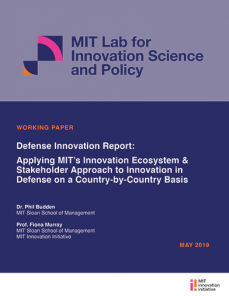


MISSION INNOVATION WORKING PAPER
The recent focus on innovation by the U.S. Department of Defense (DoD) illustrates some of the ways in which a large, established public sector bureaucracy has fostered new innovation units. It also highlights how the distinctive organizational cultures of these units can more effectively support key capabilities such as rapid experimentation, novel funding/contracting approaches, and alternative training/skills. ‘Kessel Run’, as one such organization, is a hybrid unit of the U.S. Air Force (USAF), combining acquisition and operations, established and then scaled to bring software solutions to the warfighter.

WORKING PAPER
The global transition to a digitally-based, innovation economy – accelerated during the current pandemic – has long promised to deliver major opportunities for economic prosperity and social progress. It has also brought with it, however, a wide-ranging set of problems including digital security – and with those challenges, a growing attention to the importance of cybersecurity to the global internet and ‘world wide web.’

POLICY WORKING PAPER
Governments and foundations around the world are urgently seeking strategies to optimize their investments across a range of distinctive missions targeted towards societal challenges. How should such investments be made, from early R&D spending to later-stage acceleration, to most effectively fuel the full lifecycle of innovation from ideas to impact? We answer this fundamental and urgent question by analyzing the boundary conditions of the most influential model of mission-driven innovation thus far, the much lauded Defense Advanced Research Project Agency (DARPA).

Prof. Fiona Murray, Dr. Phil Budden, Ogbogu Ukuku
Download PDFWORKING PAPER
In today’s innovation economy, small enterprises play a range of vital roles. As plans emerge to ‘re-build’ after the COVID-19 crisis and economic lockdowns, it is important to distinguish among these different types of small enterprises, and to assess how the recession has impacted them. As we saw in the 2010s, the recovery after the ‘great recession’ was not evenly distributed, resulting in inequitable economic, social and healthcare outcomes. For the coming recovery, and the hope to ‘build back better’ this time, a fuller understanding of the range of small enterprises, their importance and needs, might help avoid some of the challenges that emerged last time.
To that end, we offer this Working Paper, both as a review of some approaches to small businesses over the last decade – especially of the focus on start-ups and on definitions of small and medium-sized enterprises (SMEs) – but also with a proposed new framework with a broader range, so that business support and ecosystem policies are optimised for the variety of small enterprises in the innovation economy of the 2020s. The precise mix of businesses will of course vary by country, region and community, but we hope this Paper will be a contribution that helps those with an interest in assessing their current mix, and in planning for a desired diversity, of such small enterprises, in the interests of ‘building back’ a more inclusive economic recovery.

Prof. Fiona Murray, Dr. Phil Budden
Download PDFWORKING PAPER
MIT’s study of innovation emphasizes practical approaches for leaders striving to build effective innovative behaviors as well as long-run capabilities for innovation in their organizations. Given the challenges that leaders face in these efforts, a key to MIT’s approach is the ‘Three Lenses’ perspective on organizations; a framework developed in the 1990s by MIT colleagues for the 1st edition of Managing for the Future. The framework is an especially useful way to understand both the challenges and the opportunities that leaders confront – or are likely to confront – when making meaningful strides towards innovation, especially in large public and private sector organizations.

Prof. Fiona Murray, Dr. Phil Budden
Download PDFWORKING PAPER
Innovation can mean many things to many people, and no-one has a monopoly: as such, it risks becoming a buzzword, surrounded by others, but it is in fact a key phenomenon. Below we set out the key elements of the MIT definition and approach. From this understanding flows our analysis of the process and how a state’s various innovation units and agencies operate in the wider national innovation system in which they exist and engage the external ecosystem(s).

SEMINAR SUMMARY
A summary of the conversations from the Enhancing Cybersecurity – The Role of Innovation Ecosystems seminar that took place on February 13, 2019. The goal of the seminar was to advance participants’ knowledge of innovation ecosystems for innovation in cybersecurity. Its approach was to emphasize the growing agglomeration of innovation-driven enterprises creating innovative solutions, and the tightly-coupled interdependencies in these hubs of entrepreneurs, governments, risk-capital, universities and large corporations.

Kathryn Person, Dylan Cohen, Jonathan Miller, Fiona Murray
Download PDFREPORT
The Naval Surface Warfare Center, Crane Division, (NSWC Crane) is successfully responding to the needs of the Department of Defense and serves as a catalyst for regional industrial development. Its ability to achieve this dual national and regional mission is an example for other defense laboratories in the wider Defense Laboratory Enterprise.

Prof. Fiona Murray, Dr. Phil Budden
Download PDFWORKING PAPER
Government actors in the innovation space play a range of roles: these are in large part determined by the dynamics of each nation’s state ‘system’ of agencies, the wider ‘ecosystem’ in which they operate and their specific organizational mandate. Some agencies play more than one role at the same time, and many operate at different stages of the innovation lifecycle.